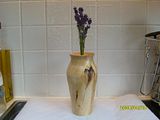I tapped a small amount of sap from a silver birch about a week ago using a method that I'd seen RM do in one of his programs - jab the point of my knife into the tree bark to make a small slit, lever it up slightly and push a small bit of twig in to hold it open while you collect the sap. He then showed that once you had finished, you just press the bark back into place and it will heal up. I did this because this seemed to be a little less intrusive than actually drilling a hole in the tree. I've also seen him suggest a sharp axe cut into the bark, which would obviously make a large wound in the tree...
...however, I was back over there a couple of days ago and had a look at the tree, and there was a clear damp patch on the bark where the tree had obviously still been seeping from the (very small) cut I'd made in the bark.
Now I'm a little concerned that either this method isn't a suitable one to use if it continues to seep several days after tapping (and maybe I should drill and plug in future) or that maybe the tree just takes a longer time to heal than I'd have expected.
Any thoughts or comments?
Geoff
...however, I was back over there a couple of days ago and had a look at the tree, and there was a clear damp patch on the bark where the tree had obviously still been seeping from the (very small) cut I'd made in the bark.
Now I'm a little concerned that either this method isn't a suitable one to use if it continues to seep several days after tapping (and maybe I should drill and plug in future) or that maybe the tree just takes a longer time to heal than I'd have expected.
Any thoughts or comments?
Geoff




 ............thank you
............thank you